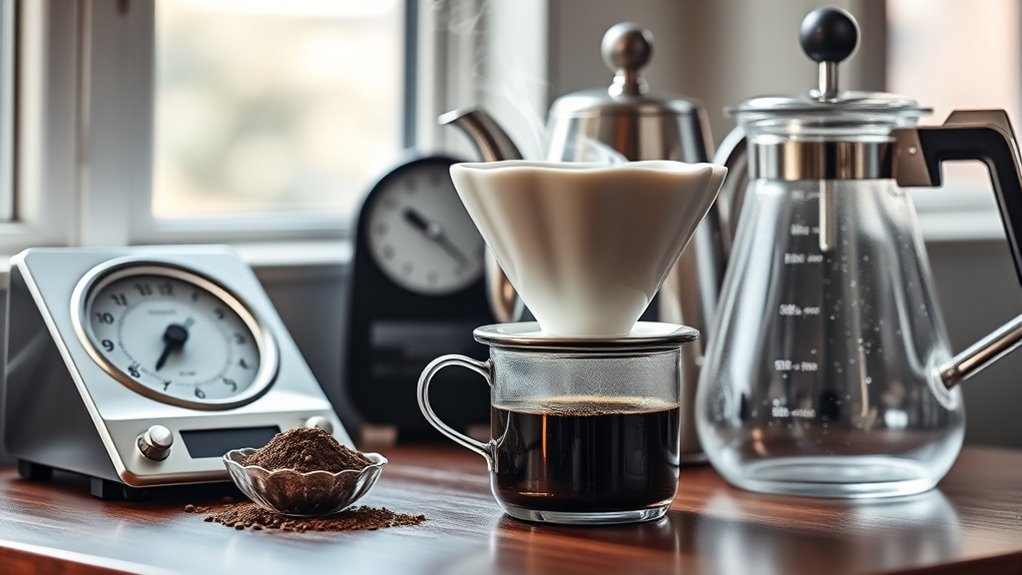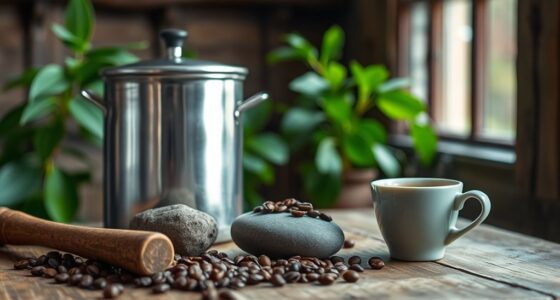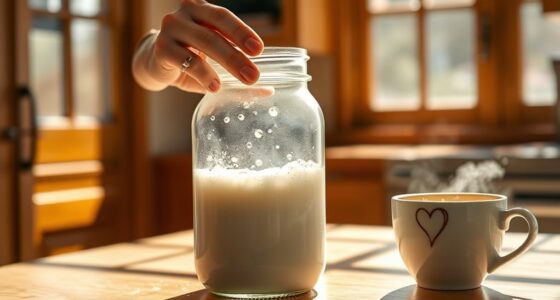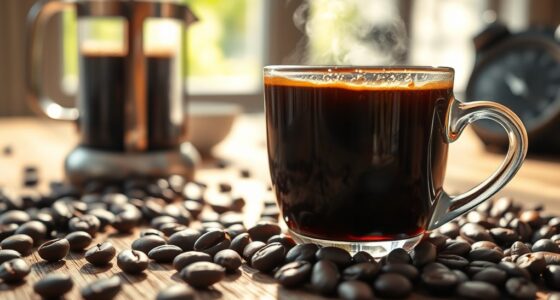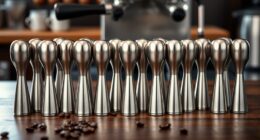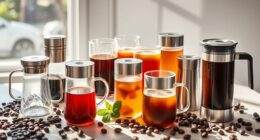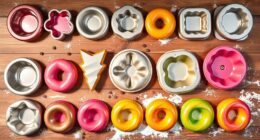To avoid common coffee brewing mistakes, prioritize using fresh ingredients. Store beans in an airtight container and keep them cool and dark. Measure your coffee and water accurately, aiming for a 17:1 ratio for ideal strength. Pay attention to grind size—coarse for French press and fine for espresso. Finally, maintain your brewing temperature between 195°F to 205°F for the best flavor. Want to enhance your coffee experience even more? There’s plenty left to explore!
Key Takeaways
- Use fresh coffee beans roasted within the last four weeks and grind them just before brewing for optimal flavor.
- Measure coffee and water accurately using a kitchen scale to maintain the recommended coffee-to-water ratio of 17:1.
- Choose the right grind size for your brewing method; coarser for French press and finer for espresso to avoid over or under-extraction.
- Ensure your brewing water temperature is between 195°F and 205°F to prevent bitterness or weak coffee.
- Store coffee beans in an airtight container in a cool, dark place to maintain freshness and aroma.
Understanding the Importance of Fresh Ingredients
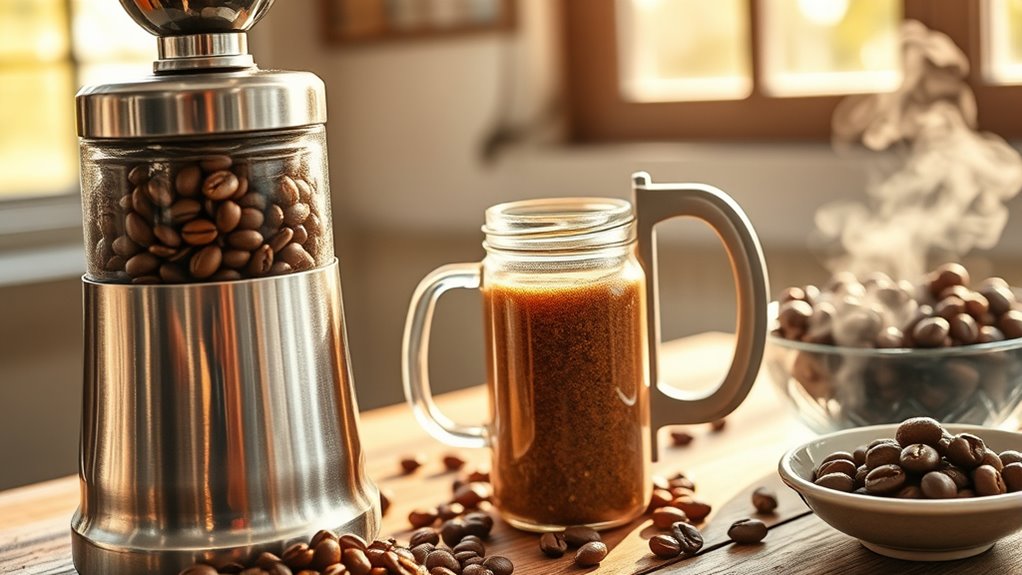
When you brew coffee, the freshness of your ingredients can make all the difference in flavor. To enjoy the best taste, always choose fresh beans roasted within the last four weeks. Grinding these beans just before brewing helps lock in their peak flavor, as ground coffee loses its freshness rapidly. Remember to use filtered water, as impurities in tap water can muddle your coffee’s flavor profile. For a balanced brew, measure about two tablespoons of coffee per six ounces of water; this ratio enhances your overall experience. Additionally, using a French Press can bring out the rich, full-bodied flavors of your coffee. Storing your beans in an airtight container in a cool, dark place will also help maintain their freshness, ensuring every cup you brew is rich and flavorful. Incorporating chia seeds into your breakfast can also enhance your cognitive function and overall enjoyment of your coffee, as their high fiber content aids in digestion and helps you feel full longer. Additionally, understanding the mechanics of French press can further enhance your brewing experience. Choosing high-quality beans can contribute to improved cognitive function and overall enjoyment of your coffee.
Proper Coffee Bean Storage Techniques

Fresh ingredients are only part of the equation; how you store your coffee beans plays a significant role in maintaining their flavor. To keep your coffee fresh, follow these storage techniques:
| Storage Method | Tips |
|---|---|
| Airtight Container | Minimize air exposure to prevent staleness. |
| Cool, Dark Place | Avoid heat and light to protect flavor. |
| Check Roast Date | Buy smaller quantities to enjoy freshness. |
Don’t store coffee in the freezer; moisture can ruin its taste. Instead, opt for a humidity-free environment. Always check the roast date on your beans, aiming to consume them within four weeks for the best flavor and aroma. Proper storage will enhance your brewing experience!
The Impact of Grind Size on Flavor
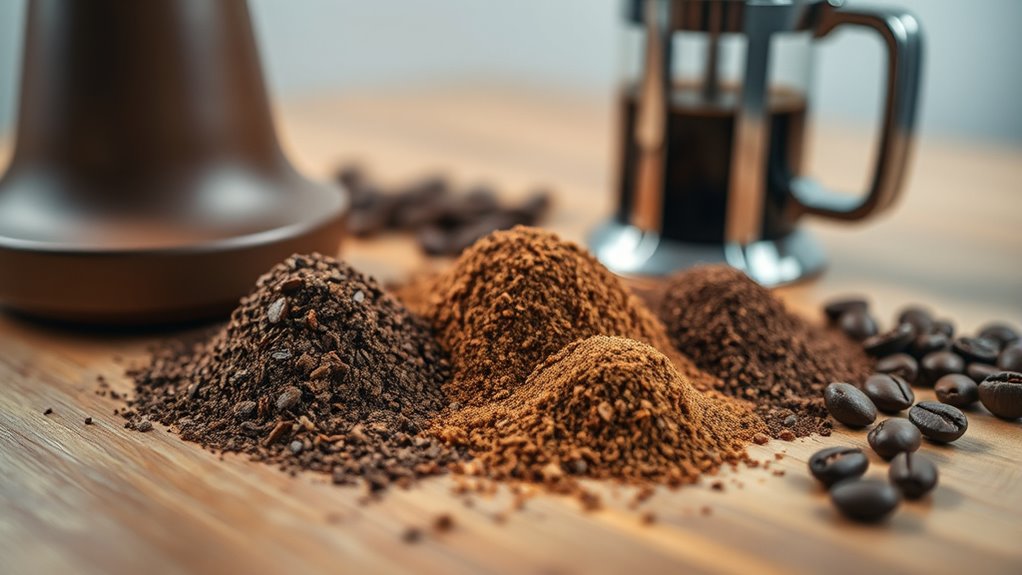
Grind size plays a crucial role in how your coffee tastes. It directly influences the extraction process, affecting flavor balance.
Grind size significantly impacts coffee flavor, directly affecting extraction and overall balance.
For methods like French press, coarser grinds work best, while espresso machines require finer grinds. A medium grind, similar to granulated sugar, is perfect for drip brewing, allowing for a well-rounded flavor without a bitter taste.
If you use a grind that’s too fine, you risk over-extraction, which can lead to unpleasant bitterness. Conversely, a grind that’s too coarse may result in under-extraction, leaving your coffee weak.
Consistency is key; uneven grinds can create an imbalanced cup. Experimenting with different grind sizes will help you customize your flavor profile to match your brewing method for optimal results. Additionally, many sustainable brands prioritize eco-friendly practices in their coffee sourcing to enhance flavor and support ethical production.
Measuring Coffee and Water Ratios Accurately

Getting the coffee-to-water ratio right is essential for brewing a delicious cup of coffee. To achieve this, consider the following tips for measuring coffee and water accurately:
- Use a kitchen scale to weigh your coffee grounds—this guarantees consistency.
- Stick to the standard water-to-coffee ratio of 17:1; for every 17 grams of water, use 1 gram of coffee.
- Avoid eyeballing measurements; it can lead to a watery or weak flavor.
- Adjust the ratio based on personal taste, but always measure carefully to maintain strength.
Maintaining Optimal Brewing Temperature

To brew a perfect cup of coffee, maintaining the right temperature is essential, as it directly affects flavor extraction. The ideal temperature for brewing coffee is between 195°F and 205°F (90°C to 96°C).
Maintaining the right temperature is crucial for brewing coffee, ideally between 195°F and 205°F for optimal flavor extraction.
If your hot water is too hot, you’ll end up with a bitter brew, while water that’s too cold results in weak, under-extracted coffee. To keep your temperature consistent, opt for brewing methods like the French press or pour-over, which give you better control.
Be aware that some electric coffee brewers may not reach this ideal temperature, so investing in a high-quality machine can elevate your coffee experience.
Also, pre-warming your coffee cup with hot water helps maintain the temperature of your freshly brewed coffee longer.
Frequently Asked Questions
What Is the 80/20 Rule for Coffee?
The 80/20 rule for coffee means that 80% of your coffee’s flavor comes from just 20% of the brewing process.
To make the most of this, focus on key elements like using freshly roasted beans and maintaining water temperature between 195°F and 205°F.
By optimizing grind size and coffee-to-water ratio, you can enhance the flavor considerably.
What Is the Golden Rule for Brewing Coffee?
When you brew coffee, think of it as crafting a perfect potion.
The golden rule is your magic ratio: two tablespoons of coffee grounds for every six ounces of water. This balance reveals rich flavors.
Keep your water temperature between 195°F and 205°F—too hot or cold, and you’ll miss out on that deep taste.
Always use fresh beans, and grind them just before brewing for the ultimate experience.
Enjoy each sip!
What Are the Three T’s of Coffee Brewing?
The three T’s of coffee brewing are Time, Temperature, and Taste. You need to pay attention to how long your coffee grounds steep, as this affects flavor strength.
Make sure your water temperature is between 195°F and 205°F to avoid scalding or under-extracting your coffee.
Finally, remember that Taste is subjective—experimenting with the first two T’s allows you to fine-tune your brew to suit your personal preferences for a perfect cup.
What Are the 7 Fundamentals of Coffee Brewing?
You might think brewing coffee is simple, but small details matter.
To brew the perfect cup, remember these seven fundamentals: use freshly roasted beans, measure your coffee grounds accurately, heat water to the right temperature (195°F to 205°F), grind beans just before brewing, store them properly in an airtight container, and adjust your coffee-to-water ratio.
Following these steps will elevate your coffee experience, ensuring each cup is rich, flavorful, and satisfying.
Conclusion
By avoiding common coffee brewing mistakes, you’ll elevate your daily cup to new heights. Did you know that about 60% of coffee drinkers don’t use the right coffee-to-water ratio? This simple adjustment can dramatically enhance flavor and aroma. Remember, using fresh ingredients and proper techniques is key. So, next time you brew, pay attention to those details, and enjoy a consistently delicious cup of coffee that’s worth savoring every morning!
